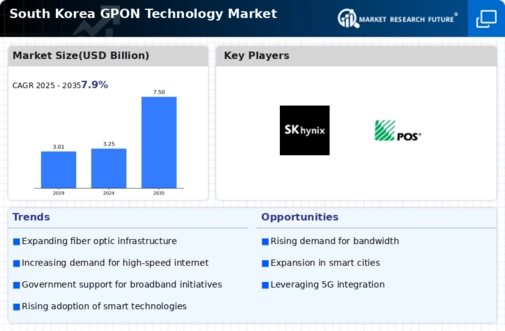The South Korea GPON Technology Market has become increasingly competitive as telecommunications providers strive to enhance their broadband capabilities and deliver faster internet services to consumers and businesses.The demand for high-speed internet connections, driven by the rise in digital services, remote work, and online entertainment, has pushed companies to adopt and integrate GPON (Gigabit Passive Optical Network) technology, which offers significant advantages in bandwidth and efficiency.
As a result, companies are focusing on innovation, network expansion, and strategic partnerships to secure their positions within this growing market.Various players are actively investing in research and development to improve their offerings, while collaborations and mergers are becoming common strategies to enhance market presence further and capitalize on the booming need for reliable and high-performance broadband networks.
LG Uplus has established itself as a formidable player in the South Korea GPON Technology Market, leveraging its extensive telecommunications infrastructure and innovative service offerings. The company has made significant investments in expanding its optical fiber network, ensuring widespread coverage and access to high-speed internet across urban and rural areas.
One key strength of LG Uplus lies in its commitment to delivering top-notch service quality, which includes high reliability and minimal downtime. Additionally, LG Uplus focuses on customer-centric solutions, providing tailored services that meet the diverse needs of both residential and business users.
The company’s strong brand recognition and reputation further enhance its competitive position within the market, allowing it to capture and retain a substantial customer base.Open Fiber has emerged as an important player in the South Korea GPON Technology Market, emphasizing the provision of advanced fiber optic solutions and services. The company offers a range of key products, including high-speed broadband connectivity tailored for residential, commercial, and institutional clients.
Open Fiber maintains a significant market presence due to its strategic partnerships and collaborations that facilitate innovative deployments and expansive network reach. The company's strengths lie in its ability to deliver reliable and cost-effective fiber solutions, bolstered by a focus on customer satisfaction and technological advancement.
Open Fiber has also engaged in mergers and acquisitions that enhance its operational capabilities and expand its footprint within the South Korean market. This commitment to growth and development positions Open Fiber favorably in the competitive landscape of GPON technology, allowing it to adapt and thrive amid evolving market demands.












